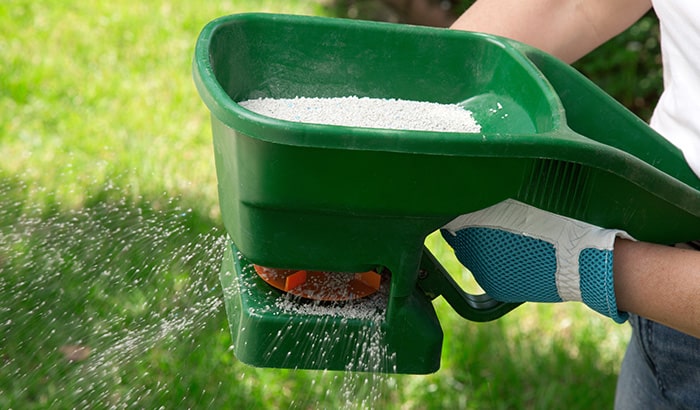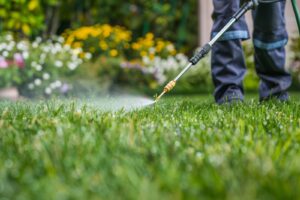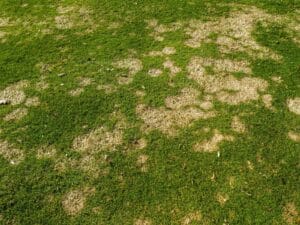As the seasons change, so do your lawn care needs. Amidst the cycle of growth and dormancy, it’s not always easy to interpret the silent pleas for care that your lawn gives you.
From the subtle yellowing of blades to the more obvious patches of bare earth, your lawn communicates its needs in various ways. In this insightful blog, we’ll explore the key signs that indicate your lawn is yearning for fertilization.
Whether you’re a seasoned gardener or a green-thumbed novice, understanding these signals is crucial in maintaining the lushness and vitality of your lawn. So, let’s delve into the world of lawn care and uncover the secrets to a vibrant, healthy lawn that stands the test of time.
Understanding lawn nutrition
Lawn nutrition encompasses the essential nutrients required for your lawn’s healthy growth and development. Like any living organism, grass needs a balanced diet to thrive, primarily composed of three key nutrients: Nitrogen (N), Phosphorus (P), and Potassium (K).
Nitrogen is crucial for promoting lush, green growth and density of the grass. Phosphorus supports root development and helps young grass establish more quickly. Potassium, often called the “guardian nutrient,” is vital in overall plant health, aiding in water regulation, disease resistance, and tolerance to stress from temperature extremes and foot traffic.
A well-nourished lawn looks better and is more resilient against environmental stresses, pests, and diseases. Understanding and providing the right nutrition for your lawn makes the difference between a struggling, patchy yard and a vibrant, healthy landscape.
Signs you need lawn fertilization
- Discoloration and yellowing
When your lawn lacks essential nutrients, especially nitrogen, the first sign is often a loss of the vibrant green color, leading to yellowing or a general pale appearance. Fertilizing your lawn will help.
This discoloration occurs because nitrogen is a key component of chlorophyll, the molecule responsible for the green color in plants and crucial for photosynthesis. A nutrient-deficient lawn can’t produce enough chlorophyll, resulting in a lackluster appearance.
- Slow growth
A healthy lawn should grow steadily and recover quickly from wear and tear. If you notice that your grass is growing more slowly than usual or that patches damaged by foot traffic or mowing don’t seem to heal, it might be a sign that your lawn is lacking in essential nutrients like phosphorus, which is vital for energy transfer and root development in plants. Fertilizing your lawn will help resolve this.
- Weed and pest infestations
A nutrient-rich lawn is able to more effectively compete with weeds and resist pest invasions. Conversely, when your lawn is malnourished, it becomes a more hospitable environment for weeds and pests.
Weeds are particularly opportunistic, taking advantage of the weakened state of your grass to establish themselves and further deplete the soil of its nutrients. Similarly, pests often target weak or stressed lawns.
- Thinning grass and bare patches
If your lawn starts to thin out, with grass blades spaced farther apart, or you begin to notice bare patches where the grass has died off, it’s often a sign of nutrient deficiency. Grass plants can’t produce new growth effectively without adequate nutrition, leading to a sparse lawn. This thinning makes it easier for weeds to take hold, exacerbating the problem.
- Soil compaction
While not a direct sign of nutrient deficiency, compacted soil significantly hinders your lawn’s ability to absorb whatever nutrients are available. Compaction prevents air, water, and nutrients from reaching the roots effectively, leading to a host of problems, including poor growth and health.
Aeration and fertilizing your lawn together help improve nutrient uptake and overall lawn health. Aeration is the process of making small holes in the soil to alleviate compaction.
Recognizing and addressing these signs through appropriate fertilization will revitalize your lawn, restoring its lushness and vigor. Conducting a soil test to identify specific nutrient deficiencies and tailor your fertilization plan accordingly is also beneficial.
Types of lawn fertilizer
Fertilizing your lawn is vital in providing the essential nutrients your lawn needs to thrive. They come in various forms, each with its benefits and specific uses. Understanding these differences is key to choosing the right one.
Synthetic fertilizers
Synthetic fertilizers are chemically manufactured to provide a quick release of nutrients. They often contain high levels of nitrogen for rapid green growth. These fertilizers provide immediate results with a visible improvement in lawn color and growth rate shortly after applying it to your lawn.
However, using too much synthetic fertilizer may lead to nutrient runoff, which isn’t good for the environment, and salt buildup in the soil, which weakens grass growth.
Organic fertilizers
Organic fertilizers are derived from natural sources like animal manure, compost, or bone meal. They release nutrients slowly as they break down. They improve soil structure and increase microbial activity, leading to long-term lawn health. Organic fertilizers are less likely to burn the grass or contribute to environmental pollution.
Two important considerations are that results may take longer to become visible, and nutrient ratios might not be as precise as synthetic options.
Granular fertilizers
Granular fertilizers are dry pellets that release nutrients slowly over time, making it easier to control the amount of nutrients the lawn receives. Granular fertilizers are easy to apply and good for long-term nutrient provision but apply them evenly to avoid patchy growth.
Liquid fertilizers
Liquid fertilizers are concentrated liquids that you dilute with water before applying. Typically, you’ll spray liquid fertilizer through a hose-end sprayer. Grass will absorb it very quickly, but the effects are short-lived, so you’ll need more frequent applications.

Choosing the right fertilizer
To pick the right fertilizer for your lawn, take the following steps:
- Soil test: Start with a soil test to identify nutrient deficiencies and pH imbalances. This will guide you in selecting a fertilizer with the right nutrient composition.
- Grass type: Consider the specific needs of your grass type; some varieties have specific nutrient requirements.
- Season: Use a slow-release granular fertilizer in early spring or fall to support growth throughout the season. Liquid fertilizers are often more beneficial for a quick nutrient boost during the growing season.
- Environmental considerations: Opt for organic fertilizers if you’re concerned about chemical runoff and environmental impact. They’re safer for pets, children, and local wildlife.
By considering these factors and understanding the different types of fertilizers available, you can make an informed decision that will benefit your lawn’s health and appearance while also aligning with your gardening philosophy and lifestyle.
Summit Lawn & Pest Control
If the signs are clear and your lawn is calling out for nourishment, it’s time to take action. Don’t let nutrient deficiencies dull the sparkle of your green oasis. At Summit Lawn & Pest Control, we understand the language of lawns and have the expertise to bring yours back to vibrant health.
With our comprehensive lawn care services, including tailored fertilization plans, we’re equipped to address the unique needs of your lawn, ensuring it receives the perfect blend of nutrients it craves.
Don’t wait for the whispers of your lawn to become cries for help. Contact Summit Lawn & Pest Control today, and let us nurture your lawn back to its full glory. Our team of experts is ready to provide you with the solutions and care your lawn deserves.







